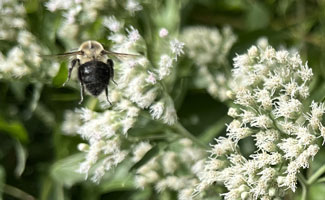
By Sarah Wilson, Healthy Planet Staff Writer
For years, I thought gardening entailed buying a “pretty”plant, watering it regularly, then dosing it with fertilizer. If I saw a “bug,” my job was to kill it. I believed all that deeply.
I was wrong.
When I was traditionally gardening, I looked for plants that pleased me. Where that plant originally came from or what part of the local ecosystem it served never entered my thoughts.“My” garden was an extension of my indoor home. I wanted straight lines and a color scheme. Nature, as such, happened somewhere else.
Now, as a native gardener, I look for plants that serve others. Can birds eat the seeds? Which pollinators benefit from the flowers? How many caterpillars (bird baby food) can it support? Nature is something I actively help because there is no “somewhere else” for it to go.
Water? Back when, I never pondered the lifetime water use of a plant/lawn. Thirsty lawns need 1-2 inches a week, every week of every growing season.
Now, some of my deep-rooted native plants needed zero additional water during the entire long, hot summer. That is less cost and hassle, leaving more water in the system for others.
And fertilizer? Plants that are not American may not thrive here without help. Fertilizer costs time and money, and that does not take into account the numerous costs to all of us of manufacture or use.
Native plants are at home. It can be hard, at first, to just plant your purchase into the unamended earth, but you get used to it. It becomes easy because it is.
As for seeing bugs, now I get excited, whipping out my cellphone to take pictures to post on iNaturalist (@growinglife), or I might just relax and watch for a while.
It’s not that native gardening is effortless; the work is just different. Most of the job is keeping healthy, flourishing plants in check. Removing healthy plants is still the hardest part for me, but it’s the right sort of “problem” to have.
The payoff? This week, the Late Boneset is in bloom. It positively drips with pollinators. As I watch hummingbirds, butterflies, bumblebees, a variety of our tiny, gentle native bees feed on what I have let thrive here, I will smile.
I’m not going back.


